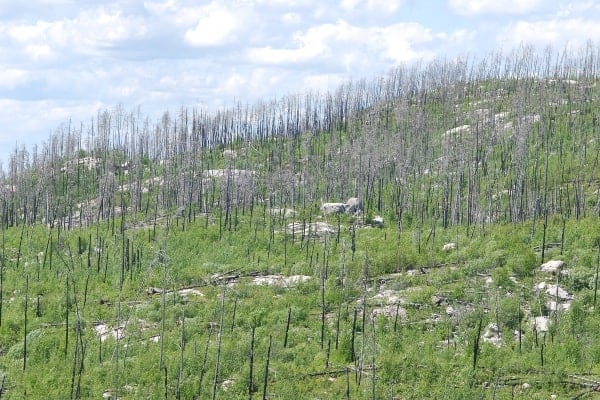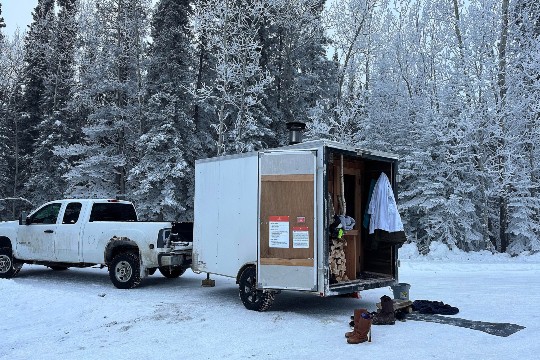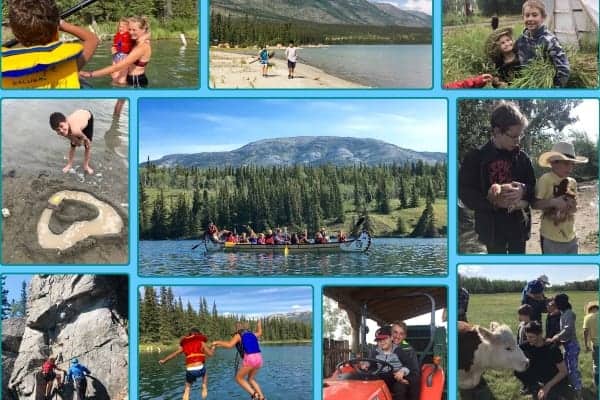How was your summer? That seems to be the question Yukoners ask each other at this time of year. Along with recounting various adventures, most of us give our summery (pun intended) of the weather.
We often talk about the summer being hot or cold, dry or wet, but we are actually talking about a portion of the summer. I doubt there has ever been a summer that was hot from start to finish. For this article, I’m going to define summer as mid-May to mid-August. As most Yukoners know, it is reasonable to say that summer is over when the fireweed starts going to seed, which is usually the beginning of August. Most of us have joked about summer taking place on a given day or week, but that can be close to the truth, if you define summer as hot.
Here is my version of the summer of 2019 in Whitehorse. It started early, with a warm May and no frost after May 13. The leaves were out by the second week in May. It was very dry through May and the first half of June. The fire risk was extreme and smoke was in the air. For most of June and July, the temperature was above average, but there were enough showers to dampen the forest. Lightning from numerous thunderstorms started some fires in the Yukon, but the Whitehorse area was spared. In short, we had a pleasant, average summer. It was an excellent summer for gardening and outdoor activity, with a reminder at the beginning that we must be mindful of our dry and combustible environment.
Whitehorse is the driest city in Canada, according to Environment Canada statistics. We receive an average of 267 millimetres (about 11 inches) of precipitation each year. That includes the water equivalent of our snowfall which is calculated at about 1 mm for each centimetre of snow. In comparison, the wettest city in Canada is Prince Rupert, with an average of 2,594 millimetres each year, about 10 times the Whitehorse average.
Summer precipitation in Whitehorse varies widely from month to month. Generally, May is dry and August is wet. June and July receive much of their total precipitation in a few showers. Precipitation records are hit and miss because showers can be very localized. I recorded a 25 millimetre total after one shower in July this year, but the automatic weather station less than one kilometre away had a fraction of that. Precipitation totals and trends over time are also affected by the last 20 years of automated measurements. Rain or snow are often recorded when none has fallen, or when there is a trace.
Older Yukoners will say that, in the old days, summers were always hot and, conversely, winters were always cold. It could be argued that I’m an older Yukoner and in my memory there have been a few hot summers in the last 40 years. In the previous 40 years, since 1942, when accurate records were kept at the Whitehorse airport, there were several hot summers. After a quick review of 80 years of observations, the facts reveal that the summers of ’47, ’58, ’69, ’82, ’98 and ’04 were hot. There have been more than six summers with hot weather, but those listed had sustained hot weather over a month or two. Those very hot summers coincide with the big fire seasons. Even the hottest summers were only hot for three to six weeks and the hot spells were often followed by wet weather and average temperatures.
Over the past 80 years, record highs of 30 C or more have been recorded between May 28 and Aug. 18, so we won’t see another day over 30 until the end of May 2020. Records of 25 C, which could be used as the threshold for hot weather, have been observed as early as May 10 and up to and including Sept. 9. The hot summers of the past may provide good memories of swimming and camping, but they are memorable mostly because of the smoke and the fires that predominated the headlines.
The summer of 1958 was truly hot and dry and may be the best example of the ‘worst case scenario’ for a city in the boreal forest. That summer was preceded by a mild November, January and March. A very warm and dry April and May set the stage for one of the worst fires to threaten the Whitehorse area. June and July were hot and dry, with 45 days over 20 C. Although the heat was not extreme, reaching a high of 30.6 C on two days, the Takhini and Braeburn fires ravaged a huge area north and west of Whitehorse.
All 5,000 Whitehorse residents were on evacuation alert, but rain showers ended the emergency on July 19. Houses in the new town of Faro were burned to the ground in the summer of 1969. Pelly Crossing residents were evacuated to Mayo and Elsa, and residents of Porter Creek and Crestview were on evacuation alert that year. June 1969 was very hot with temperature records in the 30 C range and higher. The preceding April and May were very dry, and warmer than average. Heavy showers in mid-June ended the emergency for Whitehorse.
The Fox Lake fire burned in 1998. The weather was dry from February through to August. Every day in April was above freezing and it was extremely dry. It was hot for only about three weeks from late June to mid-July, with temperatures between 26 C and 32 C. The rest of the summer was dry and the Fox Lake fire burned until the first snowfall. The fire then resurfaced in the summer of 1999.
Other notable summers were 1994 and 2004. The Yukon and Alaska had severe fire seasons both of those years, but Whitehorse, although smoky, was not directly threatened by fire. In 1994, Whitehorse had 10 record highs from June to August. It could be argued that 2004 rivalled 1958 as one of the hottest summers ever. There were eight record highs in a row in June and a record for the number of days with 30 C or warmer. There were at least two 30 C days in August that year.
The average annual temperature at Whitehorse has climbed by a few degrees since the 1940s. In the last 30 years, the July average high temperature has increased from 19 to 20 C. The hottest July days in the last 80 years were 33.1 C in 2009, on July 29 and 30. The all-time record high for Whitehorse was 34.4 C on June 14, 1969. It would be very difficult to say that there is a trend toward warmer or wetter summers. But, it is safe to say that we have periods of very hot and dry weather, and that there is a risk of forest fires during most summers.
Summer isn’t only about heat! Arctic air masses are never far away. Cool weather, frost and even snow can be a part of a ‘normal’ summer. Record lows below zero have been recorded in July at least twice in the last 80 years and on half of the days in June and August. The average frost-free period is 90 days in Whitehorse, but there is always a risk when arctic air settles over the Yukon.
Using my definition of summer as mid-May to mid-August, there have been many summer snowfalls since 1942. Snow has never fallen in July, but has been observed on the mountain tops around Whitehorse. The latest June snow was a 4.4 centimetre dump on the 25th in 1963. The earliest August snowfall was in 1969, when 5 centimetres fell on the August 10 and 11.
In general, the central Yukon has long periods of hot and dry weather, representative of a true continental climate. Whitehorse and southwestern Yukon have shorter periods of hot, dry weather, due to the proximity to the Pacific Ocean and its modified air masses that frequently invade.
Whitehorse summers are short and can be elusive for anybody waiting for the perfect day at the beach. It’s the long, beautiful evenings and pleasant weather that make our summers memorable.




